 W
WAcipenser naccarii, the Adriatic sturgeon, is a species of fish in the family Acipenseridae. It is native to the Adriatic Sea and large rivers which flow in it of Albania, Greece, Italy, and States of former-Yugoslavia. Specimens can be seen in several public aquarium, such the Milan Aquarium, Aquarium Finisterrae, Aquarium of the Po, and Oasis of Sant'Alessio in Lombardy.
 W
WAgeneiosus militaris is a species of driftwood catfish of the family Auchenipteridae. It can be found in the La Plata River basin in South America.
 W
WAncistrus cirrhosus, the Jumbie teta, is a species of armored catfish found in the Paraná River basin of Argentina and Uruguay. This species grows to a length of 8.9 centimetres (3.5 in) SL.
 W
WAspidontus dussumieri, the lance blenny or Dussumier's blenny, is a species of combtooth blenny found in coral reefs in the Pacific and Indian Oceans. The specific name honours the French explorer and merchant Jean-Jacques Dussumier (1792-1883).
 W
WThe Atlantic sharpnose shark is a requiem shark in the family Carcharhinidae, found in the subtropical waters of the northwestern Atlantic Ocean, between latitudes 43°N and 18°N.
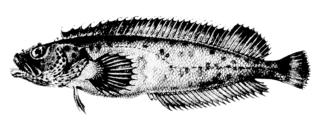 W
WAuchenionchus microcirrhis is a species of labrisomid blenny endemic to the Pacific waters off of Chile. It is a carnivorous species, eating fish, amphipods (juveniles), and decapods (adults). This species can reach 22.2 cm (8.7 in) in total length.
 W
WAuchenionchus variolosus is a species of labrisomid blenny endemic to the Pacific waters off the coast of Chile. While juveniles primarily consume amphipods, their diet shifts to decapods as the mature. This species can reach 18 cm (7.1 in) in total length.
 W
WThe bartail jawfish is a species of jawfish known only from reefs in the Atlantic Ocean off the coast of southern Brazil. This species can reach a length of 11.4 centimetres (4.5 in) SL. The specific name honours the French naturalist Georges Cuvier (1769-1832).
 W
WThe black-tailed butterflyfish, also known as blacktail butterflyfish or exquisite butterflyfish, is a species of butterflyfish native to the Middle East.
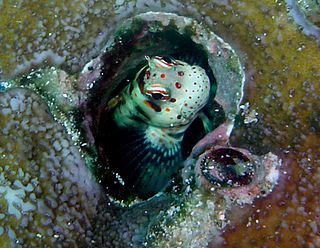 W
WBlenniella periophthalmus is a species of combtooth blenny found in coral reefs in the Pacific and Indian oceans. It is commonly known as the blue-dashed rockskipper, bullethead rockskipper, false rockskipper, or the peppered blenny.
 W
WThe Brazilian cownose ray, also commonly called the Ticon cownose ray, is a species of fish in the family Rhinopteridae. It is an endangered species, endemic to the coasts of Brazil. Its natural habitats are shallow seas, estuarine waters, and intertidal flats.
 W
WCirrhibarbis capensis, the barbelled klipfish, is a species of clinid found in subtropical waters of the Atlantic Ocean around South Africa. This species can reach a maximum length of 36 centimetres (14 in) TL. This species preys primarily on benthic crustaceans, mostly amphipods and isopods. It is currently the only known member of its genus.
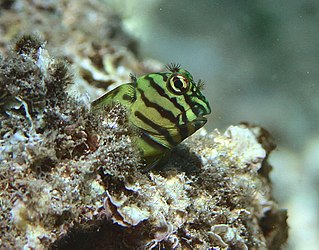 W
WCirripectes castaneus, the chestnut eyelash-blenny, is a species of combtooth blenny found in coral reefs in the western Pacific and Indian oceans. This species reaches a length of 12.5 centimetres (4.9 in) TL.
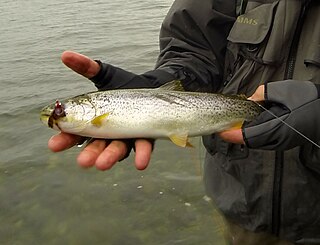 W
WThe coastal cutthroat trout also known as the sea-run cutthroat trout, blue-back trout or harvest trout is one of the several subspecies of cutthroat trout found in Western North America. The coastal cutthroat trout occurs in four distinct forms. A semi-anadromous or sea-run form is the most well known. Freshwater forms occur in both large and small rivers and streams and lake environments. The native range of the coastal cutthroat trout extends south from the southern coastline of the Kenai Peninsula in Alaska to the Eel River in Northern California. Coastal cutthroat trout are resident in tributary streams and rivers of the Pacific basin and are rarely found more than 100 miles (160 km) from the ocean.
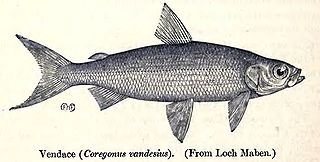 W
WCoregonus vandesius, the vendace, is a freshwater whitefish found in the United Kingdom. Population surveys since the 1960s have revealed a steady decline and the fish is no longer present in some of its previous haunts but is still present in Bassenthwaite Lake and Derwent Water. The main threats it faces are eutrophication and the introduction of alien species of fish which eat its eggs and fry. The International Union for Conservation of Nature has rated its conservation status as "endangered".
 W
WThe crested weedfish, Cristiceps australis, is a species of clinid found around southern Australia in the subtidal zone from low water to depths of about 30 metres (98 ft) preferring areas with plentiful seaweed growth. This species can reach a length of 18 centimetres (7.1 in) TL.
 W
WThe cutthroat trout (Oncorhynchus clarkii) is a fish species of the family Salmonidae native to cold-water tributaries of the Pacific Ocean, Rocky Mountains, and Great Basin in North America. As a member of the genus Oncorhynchus, it is one of the Pacific trout, a group that includes the widely distributed rainbow trout. Cutthroat trout are popular gamefish, especially among anglers who enjoy fly fishing. The common name "cutthroat" refers to the distinctive red coloration on the underside of the lower jaw. The specific name clarkii was given to honor explorer William Clark, coleader of the Lewis and Clark Expedition.
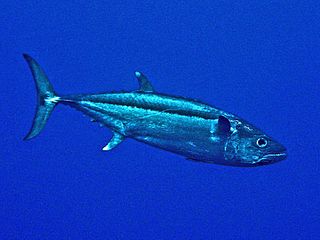 W
WThe dogtooth tuna Gymnosarda unicolor, also known as white tuna, is a species of pelagic marine fish which belongs to the family Scombridae.
 W
WThe double-lined mackerel, is a species of Spanish mackerel in the family Scombridae. This species is sometimes also called the scad mackerel.
 W
WEcsenius frontalis, known commonly as the smooth-fin blenny in Micronesia, is a species of combtooth blenny in the genus Ecsenius. It is found in coral reefs in the western Indian ocean, in several gulfs in the Red Sea. It can reach a maximum length of 8 centimetres. Blennies in this species primarily feed off of plants, including benthic algae and weeds, and are commercial aquarium fish.
 W
WThe estuarine triplefin or the cockabully is a species of triplefin blenny in the genus Forsterygion. It was described by Achille Valenciennes in 1836. It is found in the Southwest Pacific, throughout New Zealand.
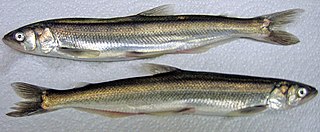 W
WThe eulachon, also called the candlefish, is a small anadromous ocean fish, a smelt found along the Pacific coast of North America from northern California to Alaska.
 W
WThe flathead chub is a species of fish in the carp family, Cyprinidae. It is the only member of the monotypic genus Platygobio. It is native to North America, where it is distributed throughout central Canada and the central United States.
 W
WThe Greenland cod, commonly known also as ogac, is a species of ray-finned fish in the cod family, Gadidae. Genetic analysis has shown that it may be the same species as the Pacific cod. It is a bottom-dwelling fish and is found on the continental shelf in the Arctic Ocean and northwestern Atlantic Ocean, its range extending from Alaska to West Greenland, then southwards along the Canadian coast to the Gulf of St. Lawrence and Cape Breton Island. It is a commercially harvested food fish, but landings have been greatly reduced in recent years.
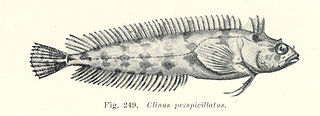 W
WHeteroclinus perspicillatus, the common weedfish, is a species of clinid native to southern Australia where it is found in seagrass beds and rocky reefs at depths of up to 10 metres (33 ft). This species can reach a maximum length of 20 centimetres (7.9 in) TL.
 W
WThe hornlip mullet is a species of fish in the mullet family from the Indo-Pacific from the Red Sea to Micronesia. It is the only species in the monospecific genus Plicomugil.
 W
WIstiblennius dussumieri, the streaky rockskipper, is a species of combtooth blenny found in coral reefs in the western Pacific and Indian Oceans. It is also commonly known as the Dussumier's rockskipper, streaky dussumier, or the Dussumier's blenny.
 W
WIstiblennius lineatus, the lined rockskipper, is a species of combtooth blenny found in coral reefs in the Pacific and Indian oceans. It is also commonly known as the lined blenny, black-lined blenny, or thin-lined rockskipper. It can reach a maximum of 15 cm (5.9 in) TL. This species can be found in the aquarium trade.
 W
WIstiblennius meleagris, the peacock rockskipper, is a species of combtooth blenny found in coral reefs in the western Pacific ocean. It is also known as the white-speckled blenny. Males can reach a maximum of 15 cm (5.9 in) TL, while females can reach a maximum of 10.6 cm (4.2 in) SL.
 W
WThe Lebranche mullet or the liza is a species of saltwater fish in the family Mugilidae. It is found in the western Atlantic Ocean and Caribbean Sea and is fished commercially.
 W
WLipophrys trigloides is a species of combtooth blenny. Distributed in the Eastern Atlantic along the coasts of France (Brittany), the Iberian Peninsula, Morocco, the Mediterranean and the Sea of Marmara southwards to Senegal, the Canary Islands and Madeira. Marine subtropical demersal fish, up to 13 cm length.
 W
WLiza carinata, the keeled mullet, is a species of grey mullet from the family Mugilidae which is found in the western Indian Ocean and eastern Mediterraean Sea. It colonised the Mediterranean by Lessepsian migration from the Red Sea through the Suez Canal. The keeled mullet is a species of minor importance in commercial fisheries.
 W
WThe lobed river mullet, also known as ludong or banak, is a freshwater mullet. While it is claimed to be endemic to Cagayan River and tributaries extending through the watersheds of Cagayan Valley and the Santa-Abra River Systems of Ilocos Sur and Abra in the Philippines, verifiable and reliable sources have listed Celebes, New Caledonia, New Hebrides, and Fiji as areas where the lobed river mullet may be found.
 W
WMylocheilus caurinus, the peamouth, peamouth chub, redmouth sucker or northwestern dace, is a species of freshwater ray-finned fish from the family Cyprinidae, the carps and minnows, that is found in western North America. It is the only species in its genus.
 W
WThe northern pikeminnow, or Columbia River dace is a large member of the minnow family, Cyprinidae. This predatory freshwater fish is native to northwestern North America, ranging from the Nass River basin to the Columbia River basin. A good deal of concern has been expressed regarding the impact northern pikeminnow populations may have on salmon in Columbia and Snake river impoundments.
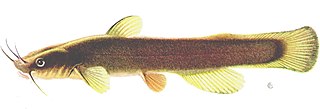 W
WNoturus insignis is a small species of North American catfish belonging to the family Ictaluridae.
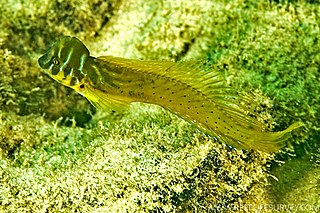 W
WOmobranchus anolius, the oyster blenny, is a species of combtooth blenny found in coral reefs in the western Pacific ocean. It can reach a maximum length of 7.5 centimetres (3.0 in) TL.
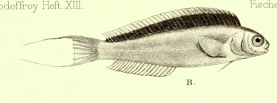 W
WOmobranchus punctatus, the muzzled blenny or the spotted oyster blenny is a species of combtooth blenny found in coral reefs in the Pacific and Indian ocean. This species can reach a length of 9.5 centimetres (3.7 in) SL.
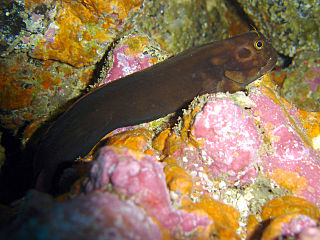 W
WOphioblennius atlanticus, also known as the redlip blenny and the horseface blenny, is a species of combtooth blenny, family Blenniidae, found primarily in the western central Atlantic ocean. Redlip blennies can be found in coral crests and shallow fringing reefs. They are highly territorial and attack intruders with two long, sharp canine teeth. The adults are found at depths of 10 to 20 meters, and the eggs are benthic. The adults may reach up to four inches in length when fully grown, and they have large reddish lips, from which they attained their names. Redlip blennies largely feed on algae.
 W
WThe Pacific lamprey is an anadromous parasitic lamprey from the Pacific Coast of North America and Asia. It is a member of the Petromyzontidae family. The Pacific lamprey is also known as the three-tooth lamprey and tridentate lamprey.
 W
WPetroscirtes breviceps, the striped poison-fang blenny mimic, striped fangblenny mimic, short-head sabretooth blenny, short-headed blenny, sabretooth blenny, or the black-banded blenny, is a species of combtooth blenny found in coral reefs in the western Pacific and Indian ocean. This species reaches a length of 11 centimetres (4.3 in) SL.
 W
WThe Portuguese blenny, also known as the red blenny, is a species of combtooth blenny found in the eastern Atlantic ocean off western Europe and Macaronesia.
 W
WCottus asper is a species of fish in the sculpin family known by the common name prickly sculpin. It is native to the river drainages of the Pacific Slope of North America from Seward, Alaska south to the Ventura River of Southern California. It extends east of the Continental Divide in the Peace River of British Columbia. It has also been introduced to several reservoirs in Southern California.
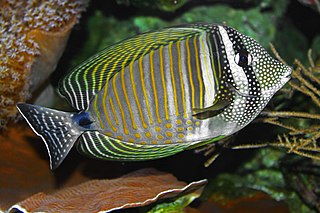 W
WThe Red Sea sailfin tang or Desjardin's sailfin tang is a marine reef tang in the fish family Acanthuridae.
 W
WThe redside shiner is a species of cyprinid fish found in the western United States and Canada.
 W
WThe redtoothed triggerfish is a triggerfish of the tropical Indo-Pacific area, and the sole member of its genus. Some other common names include blue triggerfish, redfang triggerfish, redtoothed filefish, and Niger triggerfish.
 W
WThe rock-pool blenny is a species of combtooth blenny found in the eastern central Atlantic Ocean. This species reaches a length of 12 centimetres (4.7 in) SL.
 W
WSalaria basilisca is a species of combtooth blenny found in the Mediterranean Sea near Tunisia and Turkey, also in the Adriatic Sea. This species reaches a length of 18 centimetres (7.1 in) TL. It is found among seagrass, sometimes where there is a rocky substrate. The male guards the eggs produced by several females. They are protogynous hermaphrodites with individuals being females while young changing to males later.
 W
WSalarias guttatus, the breast-spot blenny or the blue-spot blenny, is a species of combtooth blenny found in the western Pacific Ocean. This species reaches a length of 10 centimetres (3.9 in) TL.
 W
WScartichthys variolatus is a species of combtooth blenny found around islands in the southeast Pacific ocean, the Desventuradas Islands and the Juan Fernandez Islands. This species reaches a length of 16.3 centimetres (6.4 in) SL.
 W
WThe sixgill hagfish or snotslang is a species of marine fish in the hagfish family of order Myxiniformes. It is native to the South Atlantic Ocean and southwestern Indian Ocean.
 W
WThe slimy sculpin,, is a freshwater species of fish belonging to the family Cottidae, which is the largest sculpin family. They usually inhabit cold rocky streams or lakes across North America, ranging from the Great Lakes, southeast Minnesota, northeast Iowa, southwest Wisconsin and northeast Canada. Slimy sculpins have also been found roaming the cold streams of eastern Siberia. They are commonly confused with their closely related relatives, Mottled sculpin, and with tubenose gobies who are both freshwater fishes as well. The slimy sculpin is a nocturnal fish that usually spends most of its time on the stream bottom and seeks shelter under rocks and logs, especially during spawning season. When it swims, it sometimes appears to be "hopping" along the bottom because of its inefficient ability to swim. This is partly due to the absence of a swim bladder, which normally gives buoyancy to a fish.
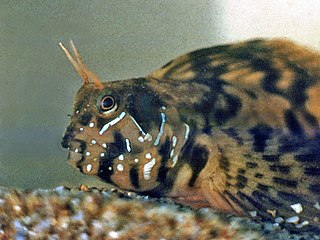 W
WThe sphinx blenny is a species of combtooth blenny, and the only species in the genus Aidablennius. It was described by Achille Valenciennes in 1836, originally under the genus Blennius, and was later reassigned under "Aidablennius" by Gilbert Percy Whitley in 1947. It is a subtropical blenny known from Morocco, in the eastern Atlantic Ocean, and also from the Mediterranean and Black Seas. Sphinx blennies inhabit shallow, rocky waters in the littoral zone, with sunlight exposure. They feed primarily on benthic algae, weeds and invertebrates. Sphinx blennies can measure up to 8 centimetres (3.1 in) long in total length.
 W
WMeiacanthus grammistes the striped blenny, also called the striped fang blenny, grammistes blenny, line-spot harptail blenny or striped poison-fang blenny, is a species of combtooth blenny from the western Pacific Ocean. The fish stays in the open ocean, but travels into shallow saltwater and brackish estuaries. This venomous species occasionally makes its way into the aquarium trade.
 W
WThe white mullet or silver mullet is a tropical and subtropical marine fish of the family Mugilidae. It is commonly about 30 cm long.
 W
WWhite sturgeon is a species of sturgeon in the family Acipenseridae of the order Acipenseriformes. They are an anadromous fish species ranging in the Eastern Pacific; from the Gulf of Alaska to Monterey, California. However, some are landlocked in the Columbia River Drainage, Montana, and Lake Shasta in California, with reported sightings in northern Baja California, Mexico.
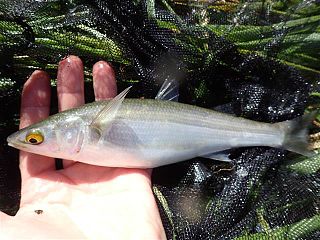 W
W